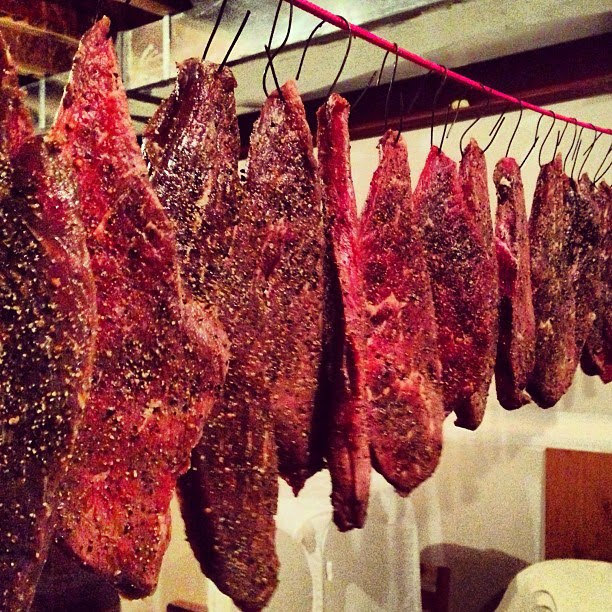From Mike B.
Biltong is the South African hunter’s friend. It is cured and dried meat, typically made from raw fillets of meat cut into strips following the grain of the muscle, or flat pieces sliced across the grain. It is similar to beef jerky in that they are both spiced, dried meats, but differ in their typical ingredients, the texture and the process of curing. Biltong is thicker, less sweet, and has more of a vinegar taste, which is less sweet but equally delicious.
It is typically dried out in the cold open air, or in wooden-boxes or climate controlled rooms. Your oven will work for this recipe.
The best cuts are obviously the loin, sirloin, and flank. But this works with any cut or kind of meat. It also works well with beef and Mike likes to use beef round, which is less expensive than the more desirable cuts listed above, but comes out equally delicious.
Three hours of curing time. 2-5 days of drying time.
INGREDIENTS:
- 4 lbs. elk, venison, or beef. The loin, sirloin or flank works well, as does the round.
- The Marinade:
- 1 1/2 c. Cider Vinegar
- 1 1/2 c. White Wine Vinegar (I decided to use Sushi vinegar instead, which tones down the vinegar taste and makes it more sweet)
- The Cure:
- 1 3/4 c. Course Sea Salt
- 3/4 c. Demorara Sugar (or Brown Sugar)
- 1 tsp Baking Soda
- The Coating:
- 1 large handfull Black Peppercorns
- 1 large handfull Whole Coriander Seeds
INSTRUCTIONS:
Combine the salt, sugar and baking soda.
Using a mortar and pestle, crust the the peppercorns and coriander. Using a sharp knife, cut the beef into 1 inch thick slices, along the length of the grain of the meat. Then cut these slices, again along the lines of the grain of the meat, into approximately 1 inch by 1 inch cross-section
Place the strips of meat into a plastic container, and cover with the blended vinegars let marinade for 30 minutes. The vinegar helps to sterilise the meat, and tenderise it. After soaking, take the strips of meat out of the vinegar , reserving the vinegar.
Prepare in separate bowls the the Cure mixture, the Coatingspice mixture, and the meat.
Lightly roll in the Coating spice mixture, brushing off any excess and reserve the remaining spice mixture.
Spread a thin layer of the the Cure (salt/sugar/bicarb mixture) in the bottom of a plastic dish, then lay the strips of meat on top, forming a single layer.
The first layer of spiced and salted strips
Cover the layer of meat with more of the Cure, ensuring it covers the ends and sides of the meat, then place alternating layers of meat and Cure, with a final covering of Cure.
All the meat strips, tightly packed and covered with the curing mixture.
Cover the contaner with platic wrap, place it in a shallow tray, to catch any overflowing juices, and place a board or lid on top, and apply some gentle weight — 4 soup cans or so.
Leave to cure for 3 hours (do not leave longer than this or the meat will be too salty).
After this time, remove the meat from the cure, and scrape off most of the salt and spices sticking to the meat. Rinse the meat with the retained vinegar mixture, to remove all of the salt.
The discarded curing mixture, and cured strips of meat. Notice how dark the meat now is.
Place the meat between pieces of kitchen towel, or a clean tea towel, and dry it thoroughly.
Roll each strip of meat in the remaining spice mixture, pressing it into all the surfaces of the meat.
Take some paper clips, and give them a single ‘unbend’ to a tight S shape, as shown. You could also use wire or string to suspend the meat by. I used plastic coated paper clips to prevent any metal touching the meat.
Bent paperclips make the perfect meat hooks
Hook the larger end of the S-shape through the meat, at the thinner end (carefully avoiding poking a paper clip through your fingers), about 1.5 to 2 cm down the strip, to ensure a good hold.
Carefully hook the spiced meat strips onto the paperclips.
Hook all of the meat onto paper clips, then hang them carefully in your drying apparatus. My electric fan oven runs happily at about 35°C in ‘defrost mode’, indicated by a * symbol. I used an electric thermometer to test the temperature. Any hotter than 40°C and the meat will cook rather than dry. There are instructions, elsewhere on the internet, for various drying mechanisms, involving fans and electric light bulbs.
The slices hooked onto a metal oven shelf.
I added a tray of dishwasher (or water softener) salt, previously baked for 20 minutes at 200°C, and cooled. This is placed at the top of the over, to help absorb any moisture.
The strips in the oven, ready to begin drying
Place a tray under the strips to catch any drops, or bits of spice that fall off, and start the drying process. Leave the oven door about 1 inch/2cm ajar, to let out any evaporated moisture. I’m running the oven at 35°C all night, and in the evenings, leaving it turned off when I’m at work. It should take about 3-4 days. I’ll post back with progress. It’s done when ‘not squidgy’ to the touch, and feels completely dry and hard.
I started the meat in the oven at 16:00 yesterday, and stopped at 07:00 this morning. The meat felt very dry on the outside, but was quite yielding when pressed. Still needs a fair bit of drying.


Leave A Comment
You must be logged in to post a comment.